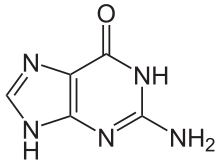CpG oligonucleotide
CpG oligonucleotides , also known as CpG oligodeoxynucleotides ( CpG-ODN hereinafter) are a class of synthetic single-stranded DNA - oligonucleotides that have a relatively high content of CpG motifs contained.
description
The CpG sequence motif is underrepresented in vertebrate DNA . Only about every sixtieth dinucleotide is of the CpG type. The letter C stands for the nucleotide cytosine , the p for phosphate and the G for the nucleotide guanine . In vertebrates, 60 to 90 percent of the cytosine of the CpG motifs is in methylated form. Statistically, every sixteenth dinucleotide in the genome of bacteria and viruses is of the CpG type and the cytosine is largely in a non-methylated form. The innate immune systemWith the toll-like receptor 9, vertebrates have a receptor that is able to recognize CpG motifs in the DNA. The protein TLR9 is mainly of certain leukocytes expressed . If a CpG motif is recognized via this protein-DNA interaction , a signal cascade is triggered. A single CpG sequence motif consists of six nucleobases, with the CG sequence in the middle and any two neighboring nucleobases being possible. Example:
5'...GACGTC...3'
This motif is repeated several times in a CpG oligonucleotide. The two most effective motives in humans are:
-
5'...TCGTT...3'and 5'...TCGTA...3'
while in mice the motive
5'...GACGTT...3'
is particularly effective.
Potential uses
The targeted activation of TLR9 by CpG oligonucleotides opens up a wide range of possibilities for using these compounds, for example to improve the effectiveness of vaccines . Initial clinical studies for use as an adjuvant have so far been promising. Furthermore, potentials are seen in the area of cancer immunotherapy , to combat infectious diseases and allergies. In tumor therapy - compared to the administration of cytokines - one promises more effective anti-tumor responses with reduced toxicity.
In contrast to CpG oligonucleotides, oligodeoxynucleotides with the TTAGGG motif have an immunosuppressive effect by imitating the body's own DNA (own DNA). The TTAGGG motif is repeated in the telomeres of vertebrates from 5 'to 3' . The administration of synthetic TTAGGG oligodeoxynuclides (TTAGGG-ODN), for example, is anti-inflammatory. These compounds are TLR9 antagonists .
History
In 1984, a working group led by the Japanese T. Tokunaga found that the DNA fraction of Bacillus Calmette-Guérin (BCG), an adjuvant known since the end of the 19th century, was sufficient to activate NK cells and their interferon production increase. In comparison, DNA from other vertebrates was unable to do this. The same working group identified in 1994 that so-called palindrome sequences, i.e. mirror-image sequences around a central dinucleotide with cytosine and guanine in the middle, were responsible for this effect and that synthetically produced oligonucleotides with this motif can show a similar effect. The American Arthur M. Krieg of the Veterans Affairs Medical Center in Iowa City and colleagues recognized in 1995 that a palindrome is not absolutely necessary for the immunogenic effect. The working group around Krieg found for the first time that these motifs stimulate their proliferation and the secretion of antibodies in murine B lymphocytes , both in vitro and in vivo . For this immunogenic effect, a possible evolutionary link between the immune defense of vertebrates, when recognizing DNA of pathogenic origin, and the suppression of the CpG motif in one's own DNA was suggested. The authors also described the potential use as an adjuvant in their publication.
Individual evidence
- ↑ AM Krieg and JN Kline: Immune effects and therapeutic applications of CpG motifs in bacterial DNA. In: Immunopharmacology 48, 2000, pp. 303-305. doi : 10.1016 / S0162-3109 (00) 00228-9 (Review)
- ↑ G. Hartmann and E. Endres: Therapeutic oligonucleotides. In: Dtsch Arztebl 100, 2003, pp. A-3102 / B-2577 / C-2406.
- ↑ ZK Ballas, WL Rasmussen, AM Krieg: Induction of NK activity in murine and human cells by CpG motifs in oligodeoxynucleotides and bacterial DNA. In: Journal of Immunology (Baltimore, Md.: 1950). Volume 157, Number 5, September 1996, pp. 1840-1845, PMID 8757300 .
- ^ R. Rankin et al .: CpG motif identification for veterinary and laboratory species demonstrates that sequence recognition is highly conserved. In: Antisense Nucleic Acid Drug Dev 11, 2001, pp. 333-240. PMID 11763350
- ↑ AM Krieg: Therapeutic potential of Toll-like receptor 9 activation. In: Nat Rev Drug Discov 5, 2006, pp. 471-484. PMID 16763660 (Review)
- ↑ L. Mühlenhoff: Effect of immunostimulatory CpG oligodeoxynucleotides on non-Hodgkin lymphomas of the B cell series. Dissertation, LMU Munich, 2003.
- ↑ D. Klinman, H. Shirota, D. Tross, T. Sato, S. Klaschik: Synthetic oligonucleotides as modulators of inflammation. In: Journal of leukocyte biology. Volume 84, number 4, October 2008, pp. 958-964, doi : 10.1189 / jlb.1107775 , PMID 18430787 , PMC 2538593 (free full text) (review).
- ↑ T. Tokunaga et al.: Antitumor activity of deoxyribonucleic acid fraction from Mycobacterium bovis BCG. I. Isolation, physicochemical characterization, and antitumor activity. In: J Natl Cancer Inst 72, 1984, pp. 955-962. PMID 6200641
- ↑ S. Yamamoto et al .: In vitro augmentation of natural killer cell activity and production of interferonalpha / beta and -gamma with deoxyribonucleic acid fraction from Mycobacterium bovis BCG. In: Jpn J Cancer Res 79, 1988, pp. 866-873. PMID 2459094
- ↑ S. Yamamoto et al .: DNA from bacteria, but not from vertebrates, induces interferons, activates natural killer cells and inhibits tumor growth. In: Microbiol Immunol 36, 1992, pp. 983-997. PMID 1281260
- ↑ T. Yamamoto et al .: Synthetic oligonucleotides with certain palindromes stimulate interferon production of human peripheral blood lymphocytes in vitro. In: Jpn J Cancer Res 85, 1994, pp. 775-779. PMID 7523351
- ↑ AM Krieg et al: CpG motifs in bacterial DNA trigger direct B-cell activation. In: Nature 374, 1995, pp. 546-549. doi : 10.1038 / 374546a0 PMID 7700380
- ↑ S. Rotenfußer include: CpG oligonucleotides: Immunotherapy after the pattern of bacterial DNA. In: Deutsches Ärzteblatt 98, 2001, pp. A981 – A985.
literature
- K. Yasuda et al: Requirement for DNA CpG Content in TLR9-Dependent Dendritic Cell Activation Induced by DNA-Containing Immune Complexes. In: J Immunol 183, 2009, pp. 3109-3117. PMID 19648272
- AM Krieg et al .: Sequence motifs in adenoviral DNA block immune activation by stimulatory CpG motifs. In: PNAS 95, 1998, pp. 12631-12636. PMID 9770537


